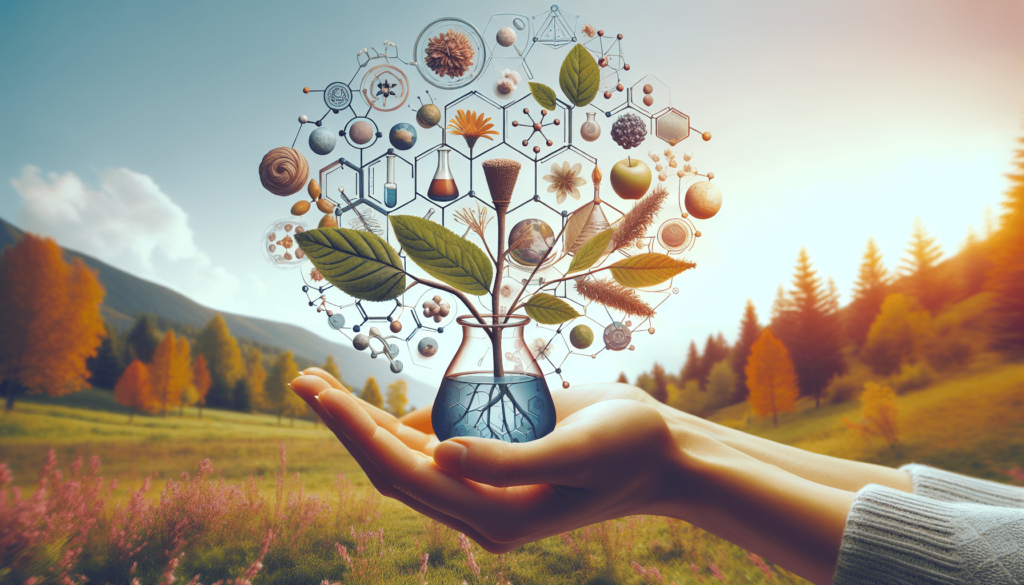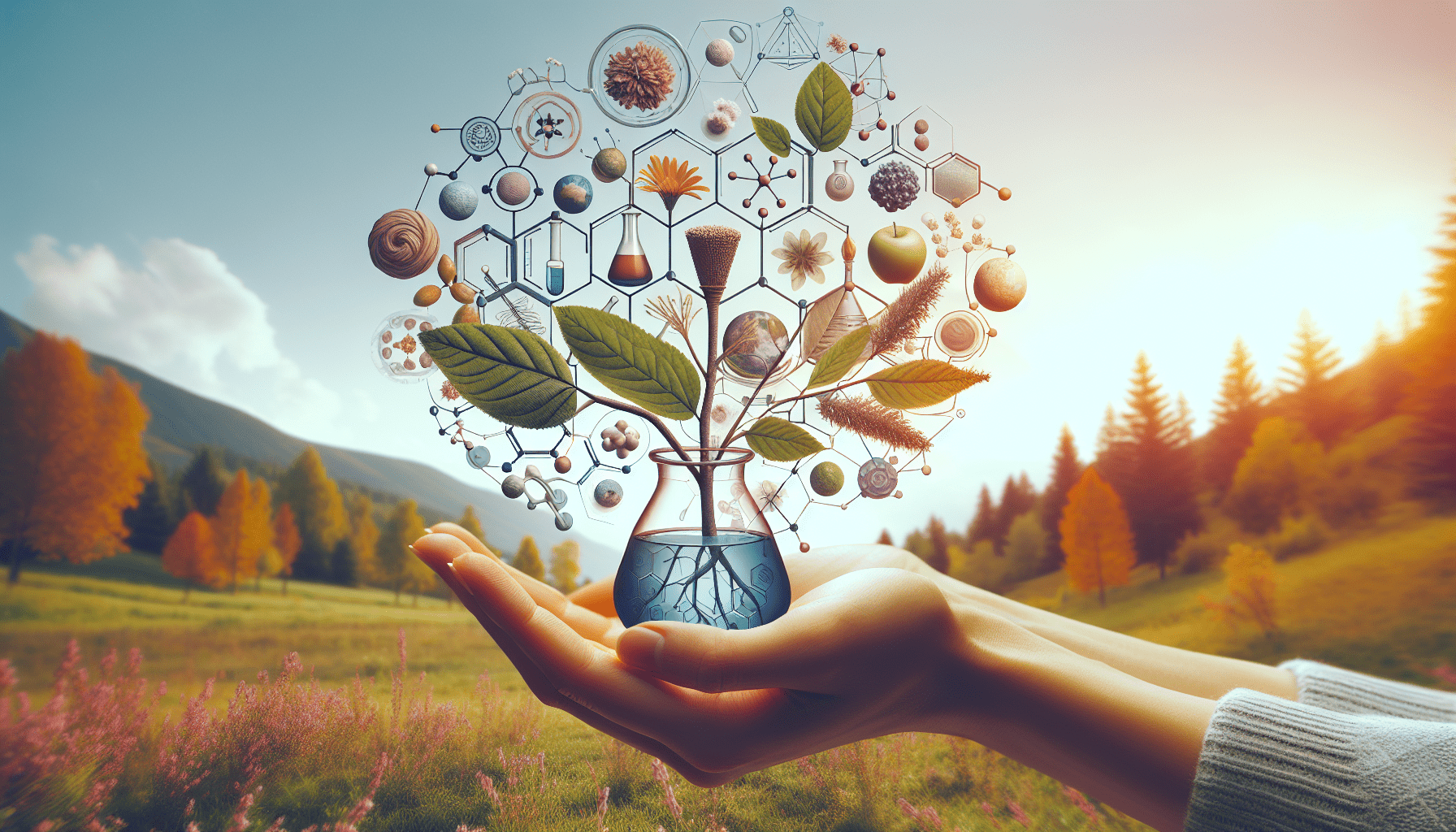In this article, you will discover the fascinating world of herbal healing and the scientific principles that underpin its effectiveness. We will explore how different herbs have been used for centuries to treat various health conditions and gain a deeper understanding of the bioactive compounds that make them so potent. Join us on this journey as we delve into the science behind this age-old practice and uncover the secrets of nature’s medicine cabinet. So sit back, relax, and prepare to be amazed by the wonders of herbal healing.

The History of Herbal Healing
Early Beginnings
Herbal healing has a rich and ancient history that dates back thousands of years. The use of plants for medicinal purposes can be traced back to ancient civilizations such as the Egyptians, Greeks, and Chinese. These early cultures recognized the healing powers of herbs and developed traditional systems of medicine based on their knowledge and experiences with medicinal plants.
Traditional Medicine Systems
Throughout history, various traditional medicine systems have emerged that rely heavily on herbal remedies. Traditional Chinese Medicine (TCM) is one such system that has been practiced for over 2,000 years. TCM views the human body as an interconnected system and uses herbs to restore balance and harmony within the body. Ayurveda, originating in ancient India, is another traditional medicine system that emphasizes the use of herbs to promote holistic health.
Adaptation in Modern Times
As we move into modern times, herbal healing has continued to evolve and adapt. The knowledge and practices of traditional medicine systems have been integrated into conventional healthcare in many parts of the world. There has also been a resurgence of interest in herbal remedies as people seek natural alternatives to conventional medicine. With advancements in scientific research and technology, the efficacy and safety of herbal remedies are now being studied and validated.
Understanding Herbal Medicine
Principles of Herbal Healing
Herbal healing is based on the principle that plants possess natural compounds that can promote healing and restore balance in the body. These compounds, known as phytochemicals, have unique therapeutic properties that can target specific ailments or support overall wellness. Herbal healers believe in the holistic approach, considering the individual’s physical, mental, and emotional well-being when prescribing herbal remedies.
Types of Herbal Preparations
Herbs can be prepared and administered in various forms to maximize their efficacy. Some common types of herbal preparations include teas, tinctures, capsules, creams, and poultices. Each preparation method allows for different levels of extraction and concentration of the active compounds in the herbs, catering to individual preferences and specific health needs.
Dosage and Administration
The dosage and administration of herbal remedies can vary depending on factors such as the individual’s age, health condition, and severity of symptoms. It is essential to seek guidance from a qualified herbalist or healthcare professional to determine the appropriate dosage and administration method for each herb. Understanding the proper usage and potential interactions with other medications is crucial to ensure safety and maximize the therapeutic benefits of herbal medicine.
Active Compounds in Herbs
Phytochemicals in Medicinal Plants
Phytochemicals are the bioactive compounds found in medicinal plants that contribute to their healing properties. These compounds include alkaloids, flavonoids, terpenoids, and phenolic compounds, among others. Each phytochemical group has unique effects on the human body, ranging from anti-inflammatory and antioxidant properties to immune system modulation and antimicrobial activity. Understanding the specific phytochemical composition of herbs is important in determining their therapeutic potential.
Synergistic Effects of Multiple Compounds
One of the fascinating aspects of herbal medicine is the synergistic effects that occur when multiple compounds in a plant work together. In many cases, the combined action of various phytochemicals enhances the therapeutic effects and increases the overall efficacy of the herbal remedy. This synergy is often referred to as the “entourage effect” and is believed to contribute to the holistic healing approach of herbal medicine.
Herbs and the Human Body
Pharmacokinetics of Herbal Medicine
The way in which herbal medicine interacts with the human body is known as pharmacokinetics. Understanding how herbs are absorbed, distributed, metabolized, and eliminated by the body is essential in determining their effectiveness and potential side effects. Factors such as the chemical composition of the herb, the dosage and administration method, and the individual’s metabolism can all influence the pharmacokinetics of herbal remedies.
Interactions with the Body’s Systems
Herbs have the ability to interact with various systems and processes within the human body. They can influence the functioning of the immune system, nervous system, cardiovascular system, digestive system, and many other physiological processes. By targeting specific receptors or enzymes, herbs can modulate biochemical pathways and restore balance in the body. Understanding these interactions is crucial for harnessing the full potential of herbal medicine.

Efficacy and Safety of Herbal Remedies
Scientific Research and Evidence
In recent years, there has been an increasing amount of scientific research aimed at studying the efficacy and safety of herbal remedies. Clinical trials, laboratory studies, and systematic reviews have provided valuable insights into the therapeutic potential of various herbs. This scientific evidence helps to validate the traditional knowledge and practices of herbal healing while also identifying any potential limitations or risks.
Potential Risks and Side Effects
While herbal remedies are generally considered safe when used appropriately, it is important to recognize that they may still carry certain risks and side effects. Some herbs may interact with medications or have adverse effects in specific populations, such as pregnant or breastfeeding women. It is crucial to consult with a healthcare professional or herbalist to ensure the safe and effective use of herbal remedies and to minimize the risk of any potential complications.
Herbal Medicine for Common Ailments
Digestive Disorders
Herbal medicine offers a range of remedies for common digestive disorders such as indigestion, bloating, and diarrhea. Herbs like ginger, peppermint, and chamomile have been traditionally used to soothe the digestive tract, reduce inflammation, and relieve symptoms. These herbs can be taken in the form of teas, capsules, or tinctures to address various digestive issues and promote overall digestive health.
Respiratory Conditions
Herbs have long been used to treat respiratory conditions, including coughs, colds, and asthma. Plants such as eucalyptus, thyme, and licorice root possess expectorant and bronchodilator properties that can help alleviate congestion, reduce inflammation, and promote clearer breathing. Inhalation of herbal steam or consumption of herbal teas can provide respiratory relief and support the body’s natural healing process.
Skin Issues
Herbal remedies have been employed for centuries to address a variety of skin issues, ranging from acne and eczema to wounds and burns. Aloe vera, calendula, and tea tree oil are just a few examples of herbs with antimicrobial, anti-inflammatory, and wound-healing properties that can promote healthy skin. Herbal creams, ointments, or infused oils can be applied topically to soothe irritation, reduce redness, and support the skin’s natural regeneration process.
Mental Health
Herbs have a long-standing history in supporting mental health and emotional well-being. Certain herbs like chamomile and lavender have calming properties that can help reduce anxiety and promote relaxation. St. John’s Wort has been traditionally used to alleviate symptoms of mild to moderate depression. While herbs can play a supportive role in mental health, it is crucial to seek professional guidance when dealing with more severe or chronic mental health conditions.
Pain Management
Herbal remedies can offer natural alternatives for managing pain, whether it be chronic pain or temporary discomfort. Turmeric, willow bark, and devil’s claw are examples of herbs that have been used to alleviate pain and reduce inflammation. These herbs can be taken internally or applied topically in the form of oils or creams. It is important to work with a healthcare professional to determine the most appropriate herbal pain management approach based on individual needs and circumstances.
Herbal Healing Across Different Cultures
Traditional Chinese Medicine
Traditional Chinese Medicine (TCM) is a holistic system of healing that utilizes herbs as a key component of its treatment approach. TCM practitioners focus on restoring balance and harmony in the body using a combination of herbal remedies, acupuncture, dietary therapy, and other modalities. TCM herbs, such as ginseng, astragalus, and goji berries, are prescribed based on individual diagnoses and are believed to strengthen the body’s natural defenses and promote overall well-being.
Ayurveda
Ayurveda, originating in ancient India, is another traditional medicine system that heavily incorporates herbal medicine. Ayurvedic herbs, such as ashwagandha, turmeric, and holy basil, are used to balance the three doshas (Vata, Pitta, and Kapha) and restore harmony to the body and mind. Ayurvedic practitioners take into account an individual’s unique constitution and prescribe personalized herbal remedies and lifestyle modifications to promote optimal health.
Native American Herbalism
Native American tribes have a rich tradition of herbal healing, utilizing the medicinal properties of plants found in their local environments. Herbs like sage, cedar, and echinacea have been used for centuries to treat various ailments and maintain overall wellness. Native American herbalism emphasizes the spiritual connection with nature and the importance of honoring and respecting the plants as allies in healing.
Other Indigenous Healing Practices
Indigenous cultures around the world have their own unique systems of herbal healing. From the Amazon rainforest to African tribes, these traditional practices often involve the use of sacred plants and plant-based remedies to address physical, mental, and spiritual imbalances. These healing practices are deeply rooted in the cultural traditions and beliefs of the indigenous communities and carry immense value in preserving their heritage and knowledge.
Controversies and Challenges in Herbal Healing
Regulation and Quality Control
While herbal medicine has gained popularity, there is a lack of standardized regulations and quality control measures. The quality and potency of herbal products on the market can vary significantly, making it crucial for consumers to choose reputable sources and brands. Additionally, the regulation and safety standards for herbal practitioners vary across different regions, leading to concerns about the qualifications and expertise of herbalists.
Misuse and Misinformation
Another challenge in herbal healing is the potential for misuse and misinformation. Without proper knowledge and guidance, individuals may misuse herbs, leading to potential risks or lack of desired results. The abundance of information available online can also contribute to confusion and misinformation. It is important for individuals to seek reliable sources of information and consult with experts to ensure safe and effective use of herbal remedies.
Lack of Standardization
The lack of standardization in herbal medicine poses challenges in terms of dosage, preparation methods, and product quality. Different manufacturers may use varying extraction techniques and concentrations of active compounds, making it difficult to compare and replicate the effects of herbal remedies. Efforts are being made to establish standardized guidelines and protocols to ensure consistency and reliability in herbal preparations.
Integration of Herbal Medicine with Conventional Treatments
Complementary and Alternative Medicine
Herbal medicine is often used as a complementary or alternative therapy alongside conventional treatments. Many individuals seek herbal remedies to support their overall well-being and manage specific health conditions. Integrating herbal medicine with conventional treatments can provide a holistic approach to healthcare, addressing both the symptoms and underlying causes of illness.
Potential Interactions with Pharmaceuticals
It is important to acknowledge that herbs can interact with pharmaceutical medications. Some herbs may enhance or inhibit the effectiveness of certain drugs, while others may increase the risk of side effects or toxicity. It is vital for healthcare professionals to consider potential herb-drug interactions, especially for individuals taking long-term medications. Open communication between patients and healthcare providers is crucial in ensuring safe and effective treatment outcomes.
The Future of Herbal Healing
Advancements in Herbal Research
As scientific interest in herbal medicine continues to grow, there is an increasing focus on researching the therapeutic potential of herbs. Advanced analytical techniques and rigorous clinical trials are being conducted to better understand the active compounds in medicinal plants and their mechanisms of action. This scientific research aims to provide evidence-based support for the traditional uses of herbal remedies and potentially discover new applications for herbal medicine.
Potential Integration into Mainstream Healthcare
With the growing body of scientific evidence and increased awareness of the benefits of herbal medicine, there is potential for greater integration of herbal healing into mainstream healthcare systems. As healthcare professionals and researchers collaborate, the efficacy and safety of herbal remedies can be further validated. This integration may involve the development of standardized protocols, guidelines for herbalists, and increased education for healthcare providers, ultimately providing more options for individuals seeking natural and holistic approaches to healthcare.
In conclusion, the history of herbal healing is ancient and diverse, spanning across cultures and civilizations. From traditional medicine systems to modern scientific research, herbal healing continues to evolve and adapt. Understanding the principles, preparations, and active compounds in herbs is crucial in harnessing their potential for healing. Herbal medicine has shown efficacy in addressing various ailments, but it is important to consider potential risks and seek professional guidance. Across different cultures, herbal healing has its unique practices and traditions, preserving the wisdom of ancient knowledge. However, challenges such as regulation, misinformation, and lack of standardization highlight the need for quality control and reliable sources of information. Integration of herbal medicine with conventional treatments offers a holistic approach to healthcare, but caution must be exercised to ensure safe and effective treatment outcomes. With advancements in research and potential integration into mainstream healthcare, the future of herbal healing holds promise for a more comprehensive and inclusive approach to wellness.

